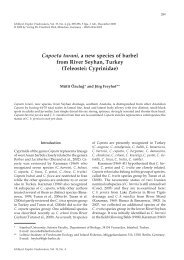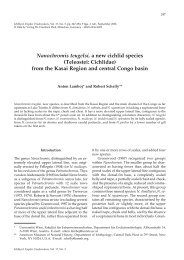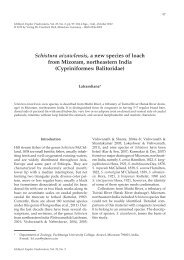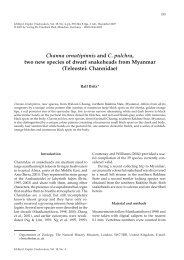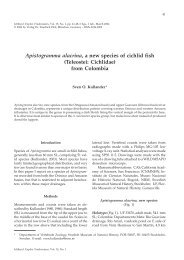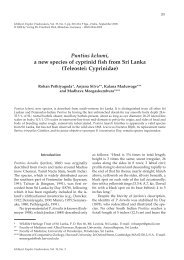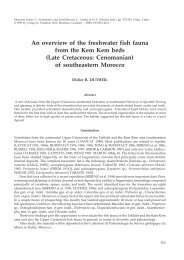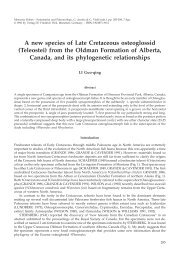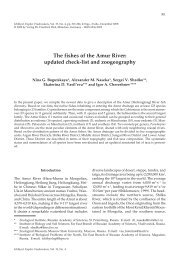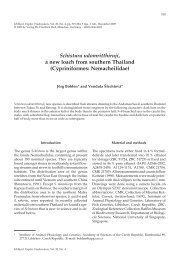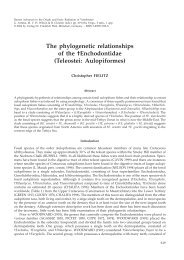A synopsis of the South Asian fishes referred to Puntius - Verlag Dr ...
A synopsis of the South Asian fishes referred to Puntius - Verlag Dr ...
A synopsis of the South Asian fishes referred to Puntius - Verlag Dr ...
Create successful ePaper yourself
Turn your PDF publications into a flip-book with our unique Google optimized e-Paper software.
72<br />
extension at 72 °C for 40 s, 35 cycles, with a final<br />
extension <strong>of</strong> 72 °C for 5 min for <strong>the</strong> 16s gene fragment;<br />
denaturation at 95 °C for 40 s, annealing at<br />
45 °C for 50 s and extension at 72 °C for 60 s, 35<br />
cycles, with a final extension <strong>of</strong> 72 °C for 5 min<br />
for <strong>the</strong> cy<strong>to</strong>chrome-b gene fragment. Products<br />
were gel purified and sequenced on an ABI 377<br />
or ABI 3100 au<strong>to</strong>mated sequencer following<br />
manufacturer’s pro<strong>to</strong>cols.<br />
The 16s sequences were aligned using Clustal<br />
X (Jeanmougin et al., 1998) and adjusted by eye<br />
using Se-Al (ver. 2.0a9; Rambaut, 1996). Positions<br />
which were difficult <strong>to</strong> align and in which we had<br />
low confidence in positional homology were<br />
excluded from subsequent analyses, leaving a<br />
<strong>to</strong>tal 411 bp. Cy<strong>to</strong>chrome-b sequences were<br />
aligned using translated amino acid sequences<br />
using Se-Al (ver. 2.0a9; Rambaut, 1996).<br />
Two Garra species (G. ceylonensis and G. mullya)<br />
were used as an outgroup for rooting <strong>the</strong> tree:<br />
<strong>the</strong> data <strong>of</strong> Yang et al. (2010) and Zheng et al.<br />
(2010) suggest that Garra is a closely-related basal<br />
genus in relation <strong>to</strong> most taxa included in this<br />
analysis. The data were analyzed using Bayesian<br />
and Maximum Parsimony (MP) criteria. We used<br />
Bayesian inference as implemented in MrBayes<br />
(Huelsenbeck & Ronquist, 2001) <strong>to</strong> generate a<br />
phylogenetic hypo<strong>the</strong>sis <strong>of</strong> relationships among<br />
<strong>the</strong> taxa and <strong>to</strong> estimate a general time-reversible<br />
model <strong>of</strong> sequence evolution with gamma-distributed<br />
rate variation among sites and a proportion<br />
<strong>of</strong> invariant sites (GTR+I+G). We ran four<br />
Metropolis-Coupled Markov Chain Monte Carlo<br />
(MCMCMC) chains for 2 000 000 generations. The<br />
summed likelihood <strong>of</strong> <strong>the</strong> four chains converged<br />
on a stationary value by 50 000 generations (<strong>the</strong><br />
burn-in time). We used <strong>the</strong> frequencies <strong>of</strong> clades<br />
in trees that were sampled every ten generations<br />
from <strong>the</strong> last 250 000 generations as estimates <strong>of</strong><br />
<strong>the</strong> posterior probabilities <strong>of</strong> those clades (Huelsenbeck<br />
et al., 2001). Uniform priors were used<br />
throughout and branch lengths, <strong>to</strong>pology, and<br />
nucleotide substitution parameters were unconstrained.<br />
For tree searches under a Maximum<br />
Parsimony criterion (all characters unordered and<br />
weighted equally) we used heuristic searches with<br />
TBR branch-swapping and random taxon addition<br />
as implemented in PAUP*4.0b10. A single tree<br />
(tree score 1919 steps) was recorded. A bootstrap<br />
analysis <strong>to</strong> determine node support was also carried<br />
out within a maximum parsimony framework.<br />
The molecular dataset used for this study<br />
can be accessed at: http://purl.org/phylo/treebase/phylows/study/TB2:S12407<br />
and http://<br />
web.mac.com/madhavameegaskumbura.<br />
Results<br />
The original dataset comprised <strong>of</strong> a 552-bp fragment<br />
<strong>of</strong> cyt-b and a 537-bp fragment <strong>of</strong> 16s. After<br />
removing poorly aligned regions <strong>of</strong> <strong>the</strong> 16s fragment,<br />
a 1060-bp fragment remained, which was<br />
used in <strong>the</strong> analyses.<br />
From our Bayesian analysis, we chose <strong>the</strong> tree<br />
having <strong>the</strong> highest likelihood value as our best<br />
tree (Fig. 1). Maximum Parsimony analysis yielded<br />
a single tree (tree length = 1919; not shown<br />
because <strong>the</strong> tree <strong>to</strong>pology from this analysis was<br />
very similar <strong>to</strong> that <strong>of</strong> <strong>the</strong> Bayesian analysis).<br />
The Bayesian analysis recovered five wellsupported<br />
clades within <strong>Puntius</strong> s. l., that we<br />
consider <strong>to</strong> be distinct genera on <strong>the</strong> basis <strong>of</strong><br />
external-morphological and osteological characters<br />
(see Table 2 for genetic distances and below<br />
for diagnoses): <strong>Puntius</strong> s. s., Sys<strong>to</strong>mus, and three<br />
new genera, Dawkinsia, <strong>Dr</strong>avidia and Pethia. The<br />
phylogeny shows that (1) Pethia is a sister group<br />
<strong>of</strong> <strong>Dr</strong>avidia and Dawkinsia; (2) Sys<strong>to</strong>mus is <strong>the</strong><br />
sister group <strong>of</strong> <strong>Puntius</strong>; and (3) [<strong>Puntius</strong> + Sys<strong>to</strong>mus]<br />
is sister <strong>to</strong> [Dawkinsia + <strong>Dr</strong>avidia + Pethia].<br />
Table 2. Percent uncorrected genetic distances between Dawkinsia, <strong>Dr</strong>avidia, Pethia, <strong>Puntius</strong> and Sys<strong>to</strong>mus for <strong>the</strong><br />
combined 16s and cyt-b fragments analysed.<br />
Pethia Dawkinsia <strong>Dr</strong>avidia Sys<strong>to</strong>mus <strong>Puntius</strong><br />
Pethia – 7.3-12.0 13.5-14.2 10.4-15.6 10.4-16.3<br />
Dawkinsia – 12.2-15.6 8.1-15.6 8.4-16.6<br />
<strong>Dr</strong>avidia – 12.7-15.6 13.0-16.6<br />
Sys<strong>to</strong>mus – 9.5-18.1<br />
Pethiyagoda et al.: Synopsis <strong>of</strong> <strong>South</strong> <strong>Asian</strong> <strong>Puntius</strong>




